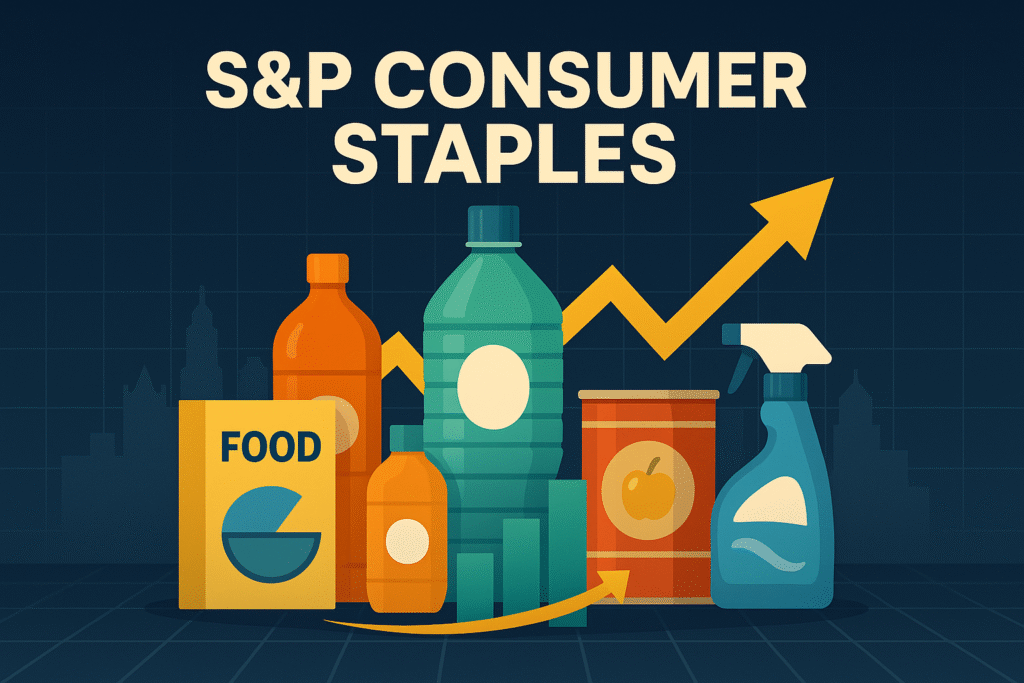Tracks the consumer‑staples companies—food, beverage, household‑product and personal‑care makers—within the S&P 500. Consequently, it gives investors a pure‑play view of defensive U.S. blue‑chips whose revenues stay resilient throughout economic cycles.

1. Snapshot (May 2025)
| Metric | Value |
|---|---|
| Constituents | 38 stocks |
| Float‑Adjusted Market Cap | US $4.1 trillion |
| Dividend Yield | 2.7 % |
| Top Three Holdings Cap | 35 % (Procter & Gamble, Coca‑Cola, Costco) |
| Ticker Symbols | S5COND (cap‑weighted), SPSCFDN (equal‑weight) |
Thus, the index represents roughly 6 % of the full S&P 500 by weight.
2. How Constituents Qualify
First and foremost, a company must already reside in the S&P 500. Next, it must carry a GICS Consumer Staples sector code, covering:
- Food & Staples Retailing (e.g., Costco)
- Beverages (Coca‑Cola, PepsiCo)
- Household & Personal Products (P&G, Colgate)
- Tobacco (Altria)
- Food Products (General Mills)
Because the parent index’s liquidity and profitability screens apply, the sub‑index remains highly tradable.
3. Weighting & Rebalancing
Constituents are float‑adjusted market‑cap weighted, capped at 35 % each when rebalanced quarterly (March, June, September, December). Consequently, mega‑caps drive returns, yet the cap stops any single stock from overwhelming the basket.
4. Performance Pulse (Total Return, USD)
| Year | Return | Key Driver |
|---|---|---|
| 2022 | –3.1 % | Rate hike multiple compression |
| 2023 | +7.9 % | Pricing power offsets inflation |
| 2024 | +6.2 % | Stable earnings, cost discipline |
| YTD 2025 | +2.8 % | Defensive rotation amid growth worries |
Altogether, the five‑year annualised return stands near 7 % with volatility ~12 %, noticeably lower than the broad S&P 500.
5. Why Investors Use It
- Defensive Allocation: Historically, staples outperform during recessions.
- Dividend Income: 55 % payout ratio delivers consistent cash flow.
- Inflation Hedge: Brand‑based pricing power passes higher costs to consumers.
- ETF Access: XLP and VDC track the cap‑weighted version, whereas RHS offers equal‑weight exposure.
6. Strengths & Caveats
| Strengths | Caveats |
|---|---|
| Low volatility and steady dividends | Growth lags in bull markets |
| Simple, quarterly cap limits single‑stock risk | Highly concentrated: top ten ≈ 70 % weight |
| Under‑pins deep derivatives market | ESG concerns around tobacco and sugary drinks |
7. Themes to Watch
- Health‑Oriented Reformulations: Sugar and sodium reductions reshape product pipelines.
- E‑Commerce Expansion: Digital grocery penetration rising toward 25 % by 2027.
- Cost‑Savings Automation: AI‑driven supply‑chain optimisation lifts margins.
- Shareholder Returns: Ongoing buyback programs, in addition to dividends, enhance total yield.
Key Takeaways
The S&P Consumer Staples index isolates the most defensive corner of the S&P 500. Thanks to strong brands and sticky demand, its members produce stable earnings and above‑market dividends, thereby cushioning portfolios when economic growth slows.